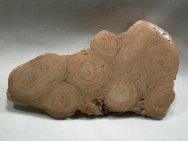 The
oval to circular structures in these images are bacterial fossil
nodules, referred to as Girvanella sp (note that while commonly
called algae balls, they were actually formed by prokaryotic, photosynthetic
bacterial, most likely cyanobacteria, the primitive organisms that
largely produced Earth's atmospheric oxygen). It has been cut and
polished perpendicularly to the individual colonial nodules and
thus beautifully exhibits the multiply colored growth rings. The
reverse affords a view of the structures in their natural state. The
oval to circular structures in these images are bacterial fossil
nodules, referred to as Girvanella sp (note that while commonly
called algae balls, they were actually formed by prokaryotic, photosynthetic
bacterial, most likely cyanobacteria, the primitive organisms that
largely produced Earth's atmospheric oxygen). It has been cut and
polished perpendicularly to the individual colonial nodules and
thus beautifully exhibits the multiply colored growth rings. The
reverse affords a view of the structures in their natural state.
These
stromatolites dates to the Upper Silurian ~ 420 million years ago
when stromatolite was no longer prevalent and abundant. By the Cambrian,
photosynthetic bacteria responsible for the biogenic formation of
stromatolite structures no longer had the earth to themselves. The
oxygenated atmosphere had become toxic to some bacteria, and they
had to compete with other organisms, some of which would have been
predaceous to this most ancient of life forms. No wonder this that
these stromatolites show the Girvanella spheres that where small
independent colonies, never reaching the large domes of the Proterozoic.
The Salina Formation derives its name from the vast deposits of
rock salt which it contains, a resource mined in several regions
throughout eastern North America.
|